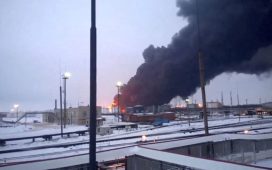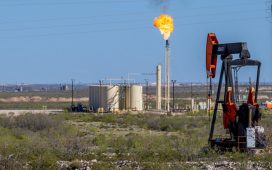
The Trump administration is moving to weaken an Obama-era regulation meant to prevent a repeat of past coal ash disasters. | Steve Helber/AP Photo
More than 100 ponds and landfills containing coal ash lie in areas FEMA has designated as high-risk flood zones, according to a POLITICO analysis.
More than 100 storage sites for coal-burning power plants’ toxic leftovers lie in areas that federal emergency managers have labeled a high risk for flooding, according to POLITICO’s examination of government and industry data.
That finding comes as scientists and pollution experts warn that coal ash — a multibillion-dollar liability problem for communities across the country — may become an even greater danger because of heavier rains triggered by climate change. Already, federal agencies warn that the government’s flood maps most likely understate the risks of deluges in much of the country, including the Southeast, where at least 42 storage sites in POLITICO’s analysis are located.
Story Continued Below
Meanwhile, the Trump administration is moving to weaken an Obama-era regulation meant to prevent a repeat of past coal ash disasters.
The ash, left behind when coal is burned for power generation, contains arsenic, selenium, lead, mercury, boron and other contaminants known to cause cancer, neurological damage or heart ailments. Electric utilities usually store it in massive landfills or unlined ponds that are at a risk of spilling when nearby lakes and rivers flood — as happened in a $1.2 billion disaster that damaged dozens of homes in Tennessee in 2008, as well as two breaches that fouled a river and lake in North Carolina last year after Hurricane Florence.
In addition to the increased risk of spills, scientists say the heavier rains expected to come from a warming planet also threaten to bring a more hidden peril — rising water tables that seep into the ash impoundments, contaminating groundwater used for agriculture and drinking.
The dangers make it urgent for power companies to move faster to remove the coal ash deposits from harm’s way, pollution experts say.
“If they don’t clean them up, they’re going to be there forever,” said Peter Goode, a former chief engineer for the Missouri Department of Natural Resources water pollution control program. “Thirty years from now, who knows what the flooding events are going to look like and what the rainfall events are going to look like?”
Adding climate change to the mix presents “a major issue,” said Ellen Cowan, a scientist at Appalachian State University who has studied coal ash spills across the country.
“That should be part of the equation: whether or not it’s safe to leave them here or whether that ash should be moved and landfilled somewhere far from bodies of water,” Cowan said.
The utility industry said it takes coal ash cleanup seriously and that the federal rule is strong. But companies have argued against a “one-size-fits-all” approach. Capping ash where it already exists “can be equally protective” as removing it from floodplains, said Jim Roewer, executive director of the Utility Solid Waste Activities Group, a coalition of electric utilities.
“The question of how to close really is a site-specific decision and you need to take a look at the site characteristics, where the groundwater is, where surface waters are,” he said.
‘We feel like we’re under assault’
To identify the potential scope of the problem, POLITICO examined company filings, EPA documents and other publicly available information on more than 370 power plants to find the precise location of their ash ponds and landfills.
POLITICO then used FEMA’s online flood map viewer to identify which sites lie within what FEMA calls a Special Flood Hazard Area. It found that at least 101 coal ash sites sit on terrain where the agency estimates at least a 1 percent chance of flooding in any given year — what is frequently known as a 100-year storm.
The examination comes with significant caveats: Flood-risk information wasn’t available for every site, and consistent documentation didn’t exist for many long-dormant coal ash sites, so POLITICO eliminated dozens of locations from its results. The results also don’t account for some utilities’ ongoing efforts to remove their coal ash. And some FEMA maps POLITICO reviewed were last updated in the 1970s.
A full analysis of any particular site’s flood risk would have to look at a range of factors, such as a pond’s elevation as well as its structural engineering, said Alan Lulloff, chief scientist at the Association of State Floodplain Managers’ Flood Science Center.
But if every coal ash site is different, they are similar in the toxins they contain. And even the Obama administration’s rule doesn’t fully address the worsening dangers climate change poses, scientists and environmentalists say.
Lawmakers and regulators in some states, such as Illinois, North Carolina and Virginia, are taking matters into their own hands by requiring utilities to haul ash away from floodplains and prove they have the money to clean up their sites. But they worry about the companies either resisting or slow-walking the efforts.
“We’ve always been concerned about those containment ponds and the leaching. We feel like we’re under assault,” said North Carolina state Sen. Harper Peterson, a Democrat whose district includes a coal ash pond that spilled when Florence struck in 2018. “It just highlighted how vulnerable we are now more than ever with storms.”
Billions in liability
The effects of flooding were either unforeseen or unacknowledged when electric companies built coal-fired power plants near bodies of water in the early and mid-20th century.
The locations made sense at the time: Barges moved coal along rivers, and power plants use tremendous amounts of water for cooling. And not unlike agricultural runoff or chemicals used in manufacturing, coal ash escaped regulation for much of its existence.
But now, utilities and nearby communities face billions of dollars in potential liability or cleanup costs. Duke Energy said adhering to the North Carolina Department of Environmental Quality’s order to excavate six sites near waterways would cost $5 billion. Dominion Energy’s cleanup at four Virginia sites will cost $3 billion under a deal brokered with the state.
Spill costs can be just as massive. The 2008 spill that sparked a push for federal rules, at a Tennessee Valley Authority power plant in Kingston, Tenn., cost $1.2 billion to clean up and has been linked to the deaths of dozens of workers who contracted cancer and other diseases after responding to the disaster. Damage from a 2014 spill on the Dan River in North Carolina reached $395 million, according to the U.S. Forest Service.
What’s more, floods and hurricanes will grow in severity as greenhouse gas emissions rise and scramble rainfall patterns, 13 federal agencies warned in last fall’s National Climate Assessment.
The assessment said flooding risk is particularly acute in the Southeast and along rivers in the Midwest. That’s where 90 of the sites in FEMA’s high-risk flood zones reside, POLITICO’s analysis found. The National Climate Assessment noted that extreme precipitation spiked 42 percent in the Midwest and 27 percent in the Southeast between 1958 and 2016, and said the Midwest and parts of the Southeast will see another 40-plus percent increase by 2100 if emissions trajectories go unchanged.
“Existing flood map boundaries do not account for future flood risk due to the increasing frequency of more intense precipitation events, as well as new development that would reduce the floodplain’s ability to manage storm water,” the climate assessment said of the Southeast.
Alice Hill, who was senior director for climate resilience on former President Barack Obama’s National Security Council, shared the agencies’ pessimistic view of future flooding risks.
“History is no longer a safe guide: the ‘1 in 100 year flood’ may occur far more frequently,” Hill said by email. “If coal ash pond flood protection does not account for changing flood risk as a result of climate change, flood protection measures may prove inadequate when flooding exceeds historical records.”
Besides being increasingly outdated, FEMA’s maps are also subject to political pressures: In 2017, just one year after Hurricane Matthew hit Duke’s retired H.F. Lee Power Station in Goldsboro, N.C., spilling coal ash into the Neuse River, the utility persuaded the agency to redraw its maps to exclude an active ash pond from the high-risk flood zone. Florence hit two different, inactive ash ponds at the power plant the following year, along with Duke’s Sutton Lake site in Wilmington.
“Magically, they were politically able to draw them out of the floodplain,” said Bobby Jones, a community organizer who lives in the majority-black city near the Lee station, where more than a quarter of the population lives below the poverty line.
Duke spokesperson Bill Norton said the old flood map for Lee’s inactive basin was inaccurate because it didn’t show that the site is elevated above the floodplain. He added that “critic groups greatly exaggerated the significance of those ‘spills’” at Lee and Sutton Lake, noting that the state Department of Environmental Quality’s testing at both locations “demonstrated that water quality remained protected.”
The risks aren’t limited to what people can see on the surface, however. Drinking water wells in rural areas that tap into groundwater already show contamination from chemicals such as arsenic, lithium, cobalt and radium near 24 coal ash sites across 13 states, according to the EPA and environmental groups Environmental Integrity Project and Earthjustice.
Groundwater contamination for pollutants such as molybdenum, arsenic, thallium, lithium, selenium, cobalt and radium also exceeded EPA health safety standards at 91 percent of 265 power plants covered by the Obama administration’s coal ash rule, the two environmental groups found based on EPA data.
EPA revisits Obama rule
The Obama administration’s 2015 rule sought to lessen the risks by requiring utilities to monitor groundwater for pollution near sites, restricting the locations where ash ponds can be placed, and establishing pollution triggers that compel utilities to close or retrofit pits with protective lining. Utilities could keep disposal sites in high-risk flood zones only if they took steps to prevent toxins from traversing through groundwater.
The rule prohibits coal ash sites in wetlands or earthquake-prone areas, and it says the bottoms of pits must sit at least 5 feet above the uppermost aquifer. It requires power companies to monitor groundwater near sites for 30 years.
The regulation compelled dozens of coal ash sites to shut down, the utilities group’s Roewer said.
“Many, perhaps even most of the facilities will close,” he said.
But environmentalists say the rule has its share of holes: It doesn’t apply to more than 100 sites that had stopped taking new coal waste before the rule took effect in 2015, even if the existing coal ash remains on site. (The Obama-era EPA also did not classify coal ash as hazardous waste, a step that many activists demanded but could have hampered its use as a recycled ingredient in wallboard and concrete.)
In addition, many utilities covered by the rule are falling behind on meeting their cleanup requirements.
And Trump’s moves would weaken the rule further. In place of the Obama rule’s restrictions on coal ash ponds in flood zones, EPA is considering letting states use as-yet-undefined “alternative, risk-based location-restrictions” that environmentalists worry will weaken efforts to prevent spills and contamination. It also has proposed letting states waive some cleanup requirements, exclude certain contaminants from pollution programs and suspend groundwater monitoring.
In July, the Trump administration also decided against requiring companies to prove they have the money to clean up future coal ash spills.
EPA said in a statement that it would not discuss pending changes to the rule.
Power companies and eco-activists also disagree about whether utilities’ existing efforts comply with the 2015 rule. For example, the rule allows utilities to cap their ash ponds instead of removing the waste if the ash is dry and water cannot infiltrate the deposits. But environmentalists contend that companies routinely flout those requirements.
Trump’s rollback could also shoot holes through the program by adding obstacles for citizen lawsuits, which have compelled the most coal ash cleanups to date, said Nat Mund, federal affairs director with the Southern Environmental Law Center. “It’s basically taking away the entire safety net,” Mund said.
At the same time, research that Appalachian State University’s Cowan has conducted with Duke University scientist Avner Vengosh suggests that coal ash spills may routinely go unreported — indicating that the problem is even bigger than commonly believed.
Their study of North Carolina’s Sutton Lake, where coal ash spilled during Florence, revealed contamination dating to 2015. Cowan believes heavy rainfall and other events linked to climate change may be the culprit.
“The train has left the station,” Vengosh said. “It’s not something in the future; it’s happening already.”
Tucker Doherty contributed graphics to this report, with text by Zack Colman.
This article tagged under:
Missing out on the latest scoops? Sign up for POLITICO Playbook and get the latest news, every morning — in your inbox.








